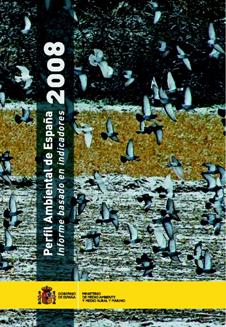Environmental Profile of Spain 2008. Indicator-based Report

The fifth edition of the Environmental Profile of Spain 2008 - Indicator-based Report, maintains the basic structure of the previous indicators. It allows to analyze the trends of the state of the environment in Spain, and the impact of the conditioning factors.
It is possible to buy copies of this report through the Ministry publications store online.
0. Presentación, Prólogo y Resumen
1. Background
- Social background
- Economic background
- Administrative background
- Environmental policy
- Environmental information
2. Indicators: areas and sectors
- 2.1 Air

- Atmospheric emissions of greenhouse gases (GHGs)
- Atmospheric emissions of acidifying and eutrophying gases and tropospheric ozone precursors
- Particulate emissions to the atmosphere
- Regional background air quality for health and vegetation protection
- 2.2 Water

- Water consumption
- Reservoir water levels
- Natural water resources
- Brackish and sea water desalination
- Nitrate pollution of groundwater
- Salinisation of groundwater bodies
- Organic pollution of rivers
- Coastal bathing water quality
- 2.3 Soil

- 2.4 Nature and biodiversity

- Protected nature areas
- Woodland defoliation
- Woodland surface area
- Cataloguing of endangered species in Spain
- Trends in common-bird populations
- Environmental monitoring
- 2.5 Waste

- Urban waste generation
- Urban waste management
- Paper-cardboard recycling
- Glass recycling
- Packaging waste recycling and recovery
- Sewage sludge production and disposal
- 2.6 Agriculture

- Fertiliser consumption
- Plant-protection product consumption
- Organic farming
- Irrigated area
- Environmental efficiency in agriculture
- 2.7 Energy

- Primary energy intensity
- CO2 emissions’ intensity
- Renewable energies
- Eco-efficiency in the energy sector
- 2.8 Industry

- Industrial atmospheric emissions
- Industrial energy consumption
- Waste generation by the industrial sector
- Total Material Requirement
- Industrial enterprises with Environmental Management Systems
- Industrial eco-efficiency
- 2.9 Fisheries

- Number of vessels and fishing fleet capacity
- Fishing fleet catches
- Aquaculture production
- Eco-efficiency in the fishing and aquaculture sectors
- 2.10 Tourism

- Number of foreign tourists per resident
- Number of foreign tourists per kilometre of coast
- Tourist Equivalent Population (TEP) compared with resident population
- Number of visitors to National Parks
- Rural tourism: accommodation, capacity, tourists and overnight stays
- 2.11 Transport

- Total inter-city transport volume: modal distribution
- Atmospheric emissions of pollutants by transport
- Air transport
- Transport waste: End-of-Life Tyres (ELTs)
- Biofuel consumption
- Motorisation and accident rate
- Transport’s environmental efficiency
- 2.12 Households

- Number of passenger vehicles per household
- Urban waste production per household
- Energy consumption per household
- CO2 emissions by the residential sector
- Household water consumption
- Gross disposable household income
- Eco-efficiency in the domestic sector
- 2.13 Urban environment

- Urban pressure on land
- Air quality in the urban environment
- Environmental noise
- Architectural heritage of Spain’s cities
- Local mobility and passenger transport
- Public participation in environmental policies
- 2.14 Natual and man made disasters

- Deaths due to natural disasters
- Drought periods
- Forest fires
- Road and rail accidents causing possible environmental damage
- Oil spills due to maritime accidents
- Industrial accidents involving hazardous substances
3. Information by Autonomous Regions: basic data
4. Apendices
- Acronyms and abbreviations
- Thematic index of indicators
- Alphabetical index of indicators
- Representatives and technicians from the EIONET Network and other expert collaborators

